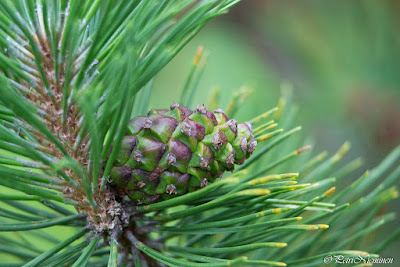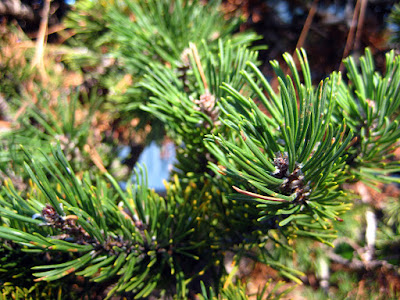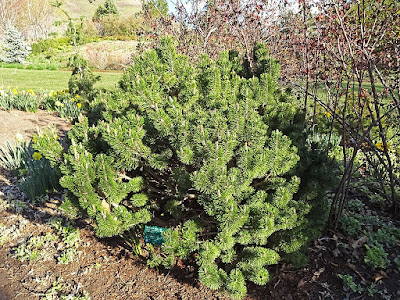Pinus mugo is native to the Pyrenees, Alps, Erzgebirge, Carpathians, northern and central Apennines, and higher Balkan Peninsula mountains. There are three subspecies: Pinus mugo subsp. mugo (occurs in the mountains of Central and Eastern Europe, from 200 to 2700 m), Pinus mugo subsp. uncinata (occurs in the Pyrenees, Western Alps and there are also scattered populations in the North-East Spain, with an altitude range from 600 to 2 400 m), Pinus mugo subsp. rotundata (present in the Alps and Central European mountains from 180 m up to 1800 m). It is hardy to USDA Hardiness Zone 2 to 7.
Pinus mugo also called as Dwarf Mountain Pine, Creeping pine, Mugo pine, Mountain pine, Scrub mountain pine, Swiss mountain pine, is a species of the genus Pinus. This species was described by Antonio Turra in 1764.
IDENTIFY PINUS MUGO - DWARF MOUNTAIN PINE PLANTS
Pinus mugo is native to the Pyrenees, Alps, Erzgebirge, Carpathians, northern and central Apennines, and higher Balkan Peninsula mountains. There are three subspecies: Pinus mugo subsp. mugo (occurs in the mountains of Central and Eastern Europe, from 200 to 2700 m), Pinus mugo subsp. uncinata (occurs in the Pyrenees, Western Alps and there are also scattered populations in the North-East Spain, with an altitude range from 600 to 2 400 m), Pinus mugo subsp. rotundata (present in the Alps and Central European mountains from 180 m up to 1800 m). It is hardy to USDA Hardiness Zone 2 to 7.
Dwarf Mountain Pine is a shrub, erect bush or small tree growing up to 5 m, sometimes with ascending branches which can spread up to 10 m from the tree, but there is also an erect form which grows as small tree up to 20 m in height. The needles are acuminate and pungent, 2 to 5 cm long, borne in fascicles of 2, and they persist on the tree up to 6 years. Physiologically the branches mature when they are 10 years old and start producing female cones in groups of 1-4, close to shoot tops. Unripe cones start diverging from the shoot, soon becoming horizontal or even reflexed; once ripe they are 2 to 5 cm long and 1.5 to 3 cm wide. The seed ripens during the second year after blossoming and is up to 5 mm long.
Swiss mountain pine are suitable in larger rock gardens as they grow very slowly. For this reason this species has also been used in bonsai culture. The wood is elastic but hard, suitable for manufacturing small items and valuable as fuel. Their needles are filled with vitamin C and carotene. A herbal tea is also made from the needles in Bulgaria. Beverages made out of them are recommended to reinforce the immune system, if one has a cold, and to cure scurvy. Needles should be used fresh, if possible moments after collecting, because they can completely lose their healing properties after a year. Syrups and liquors are commonly obtained with cones and buds.
PINUS MUGO - DWARF MOUNTAIN PINE PLANTS CARE AND CULTIVATION
The cultivation of these plants presents no special difficulties, if proper soil and exposure are available. The question of hardiness is, of course, all-important. It is not only the problem of temperature the given tree will stand, but also the exposure to winds, and, to a considerable extent, the source from which the tree is derived. If the plants are raised from seeds matured in similar or even more rigorous climates, they are usually more hardy.
Soils:
Pinus mugo prefer a well-drained porous gravelly subsoil, overlaid with a light sandy loam. They seem to be particularly happy in a soil underlaid with a porous glacial drift. In cultivation, however, they succeed very well in ordinary well-drained soil. When the plants are set in clay soil, which is often done, the soil should be thoroughly loosened by trenching or subsoil plowing, and well underdrained. Any available humus, woodashes, and well-rotted manure incorporated in the soil greatly aid in rendering it friable and porous for the roots.
Manures and mulches:
Mulching with ordinary well-rotted barnyard manure in late autumn affords much stimulus to growth. By the following spring the manure will be in a desiccated condition and can be incorporated with the soil. A heavy mulch of old straw, rotten hay, or any similar material over the roots, and this was maintained throughout the entire growing season is benefit to the plants in a more or less juvenile condition.
In many cases manure is not obtainable. In such event, newly moved plants should be heavily mulched with rotten straw, rotten hay, or any similar rubbish for a few years until they become established. The frequent stirring of the ground over the roots subsequently will conserve sufficient moisture.
An area extending from the stem to one to two feet beyond the branches, stirred up with hoe and rake perhaps five or six times throughout the growing season, is very beneficial in conserving the moisture around the roots.
Pruning:
Removal of the lower branches of Dwarf Mountain Pine is a serious mistake, and, if healthy, they should be retained to the base. Pruning or disbudding can be intelligently performed to add much to the natural symmetry. The extraction or removal, early in spring, of the central or terminal bud, will tend to compel the branches which start from the side buds to spread apart and form a much denser growth. Cutting back the previous year's terminal growth to a strong bud or branchlet on the main limbs over the tree, if the plant is inclined to be thin in its branching, always produces a much denser lateral growth.
Transplanting:
Transplanting can be done at all times of the year, excepting midsummer when they are in full growth. The best success is secured in spring when the buds begin to swell. From the end of August to the middle of September, if there have been abundant rains and the ground has been well soaked, is a very good time to move the plants. They may be planted late in autumn when circumstances compel it, but there is likely to be a considerable percentage of loss. Their roots are very susceptible to injury from exposure to the air, and the utmost vigilance should be exercised to keep them covered and moist.

















COMMENTS